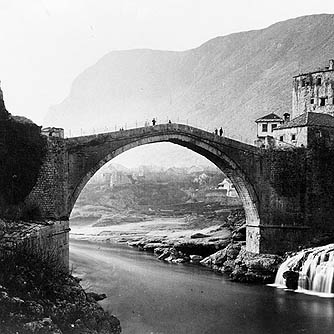
Mostar Bridge
by ArchitectureWeek
When a beloved and highly symbolic historic bridge was destroyed during the war in Bosnia and Herzegovina of the early 1990s, the whole world grieved. The single-arched Stari Most ("Old Bridge") in Mostar was erected in 1566 by architect Mimar Hajruddin at the height of the Ottoman Empire. It not only connected the city physically but, by the 20th century, had come to symbolize the coming together of many nationalities and ethnicities.
On July 23, 2004, festivities with music, dancing, and international guests celebrated the completed restoration of the landmark bridge to its original form. This reconstruction project is one piece of a larger effort to restore the historic district of Mostar after its devastation by bombing. The work is the combined effort of many entities, among them the World Monuments Fund, the Aga Khan Trust for Culture, UNESCO, the World Bank, local agencies, and donor countries.
The restoration had taken five years. According to an account by UNESCO, the bridge was rebuilt in much the same way as the original structure but with reinforcing in the foundations. "The Old Bridge was rebuilt with local materials — "Tenelija" and "Bretcha" stones found in nearby quarries — and according to traditional methods, using quoins, cramps, and dowels." The reconstruction was carried out by the Turkish company, ER-BU.
Flanked by two fortified towers, the Halebija Tower on the right bank and the Tara Tower on the left, the new bridge, like its predecessor, has a single hump-backed arch 13 feet (four meters) wide, 100 feet (30 meters) long, and 65 feet (20 meters) high at its center.
Before the Ottoman conquest of Bosnia, Mostar had been a small hamlet situated at a strategic crossing of the Neretva River. The Stari Most was built in the Ottoman period, during the reign of Suleyman the Magnificent, to replace a precarious wooden suspension bridge that had spanned the river. The stone bridge secured Mostar's primacy as the capital of Herzegovina and transformed Mostar from a quiet settlement into a cosmopolitan crossroads. The city's rich architecture, further developed during the Hapsburg period, has been a draw for travelers to this day.
On November 9, 1993, the bridge's spring line was hit by a Croatian tank shell and the already battle-damaged structure fell into the river. The war also devastated much of the city's architectural and social fabric and plunged it into decline. Later in the decade, as wartime tensions slowly faded, local and international energy went into new commercial and civic projects. The current planning and restoration work began in the late 1990s.
From the beginning, planners had realized that the reconstruction of the bridge would be an empty gesture without the concurrent rehabilitation of the historic neighborhoods. The newly created Starigrad (historic city) Agency, will help guide and manage future restoration and reconstruction projects including rebuilding the streetscapes and architecture on both sides of the river and improving pedestrian access to the historic core.
In July 2004, locals began walking across the Neretva River as they had for four centuries. It may take more time, however, before the Muslim community on one side of the river and the Croat community on the other overcome the psychological divisions carved by war.
It is hoped that the reconstruction achievements to date will inspire future work in the historic city. Considering the terrible damage inflicted during the war, much remains to be done to make Mostar whole.
http://www.architectureweek.com/today.html